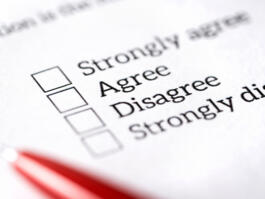Presidential Opinion Polls – The Measured vs. The Observed
Commentary By Brian C. Joondeph
With the 2020 presidential election only weeks away, increasing attention is focused on opinion polls to pick the winner. In 2016, most pollsters were wildly wrong, predicting a Hillary Clinton landslide victory over Donald Trump.
In hindsight, were quantitative measures, what can be asked and measured by a pollster, overemphasized compared to qualitative measures, things we can observe but not easily measure? Are pollsters repeating the mistakes of 2016 in 2020?
The recent NBC News/Wall Street Journal poll conducted September 30 to October 1 revealed Joe Biden leading President Trump by 14 points, 53 to 39 percent, up from an eight-point lead a week earlier. That’s the headline, but the methodology driving those numbers lies buried in footnotes and large data files.
Poll accuracy is as good as the sample polled. The poll internals showed that registered, not likely, voters were surveyed. But many, many registered voters don’t turn out on Election Day. Only 800 registered voters were surveyed, a relatively small sample size. Democrats were oversampled by nine points, 45 to 36 percent, providing much of Biden’s reported 14-point advantage.
A similar Quinnipiac poll from July showed Biden opening a 15-point lead over Trump. Again this was registered voters and oversampled Democrats by 10 points, creating much of the 15-point lead.
An ideal poll would survey likely voters and be weighted less heavily toward Democrats. There is such a poll, the weekly White House Watch by Rasmussen Reports. They survey likely voters and in their most recent survey only oversampled Democrats by four points. But their results echoed the above surveys. Biden has a 12-point lead.
Rasmussen Reports was the most accurate pollster predicting the 2016 presidential election results. Does their better methodology confirm the other poll results? Or are all the pollsters missing the qualitative over the quantitative?
What kind of prognostic factors can be observed? Polls don’t measure the plethora of Trump signs and dearth of Biden signs seen when driving around town. What about Trump rallies with tens of thousands of attendees versus Biden “rallies” with a few dozen attendees, mostly media and Secret Service?
What about voter enthusiasm? There were hundreds of Trump supporters driving their cars, trucks and motorcycles across blue state Colorado while the president was in the hospital battling COVID. Thousands of boaters rallied for Trump in a North Carolina boater parade? How about the endless parade of Trump cars a few days ago in Olympia, Washington? There is nothing remotely similar for Biden and again something easier observed than measured.
Can Trump’s confidence be measured? He is out of the hospital and will soon be on the campaign trail after recovering from COVID. He will be ready for the next debate. Democrats and the media with a straight face said that Biden easily won the first debate and that he shouldn’t do any more which makes zero sense. If Biden aced the first debate, his handlers should want him to do a dozen more, yet they don’t.
Very telling was a recent Gallup poll. When they asked those surveyed who they expected to win the election, Trump won going away, 56 to 40 percent, a 16-point margin. This latter question predicted the winner of the popular vote, although not necessarily the Electoral College winner, of each presidential election since 1996.
Polls also can’t measure that Trump is a force of nature. After dispatching 16 accomplished GOP primary candidates, he handily defeated “the smartest woman in the world.” Despite every obstacle thrown in his path, from Stormy and Avenatti to Mueller and Schiff, from impeachment to a viral pandemic, Trump has come out on top.
Opinion polls don’t measure these factors. Simply asking whoever answers the phone whom they plan on voting for does not capture the intangible. Plus many Americans are afraid to share their political views. Are the political polls accurately predicting a Biden landslide? Or are they missing many obvious but not easily measurable factors that could lead to an electoral replay of 2016? We will know soon enough.
Brian C. Joondeph, MD, is a Denver-based physician and freelance writer whose pieces have appeared in American Thinker, Daily Caller, Rasmussen Reports and other publications. Follow him on Facebook, LinkedIn, Twitter, Parler and QuodVerum.
See Other Commentaries by Brian C. Joondeph.
See Other Political Commentaries.
Views expressed in this column are those of the author, not those of Rasmussen Reports. Comments about this content should be directed to the author or syndicate.
Rasmussen Reports is a media company specializing in the collection, publication and distribution of public opinion information.
We conduct public opinion polls on a variety of topics to inform our audience on events in the news and other topics of interest. To ensure editorial control and independence, we pay for the polls ourselves and generate revenue through the sale of subscriptions, sponsorships, and advertising. Nightly polling on politics, business and lifestyle topics provides the content to update the Rasmussen Reports web site many times each day. If it's in the news, it's in our polls. Additionally, the data drives a daily update newsletter and various media outlets across the country.
Some information, including the Rasmussen Reports daily Presidential Tracking Poll and commentaries are available for free to the general public. Subscriptions are available for $4.95 a month or 34.95 a year that provide subscribers with exclusive access to more than 20 stories per week on upcoming elections, consumer confidence, and issues that affect us all. For those who are really into the numbers, Platinum Members can review demographic crosstabs and a full history of our data.
To learn more about our methodology, click here.



